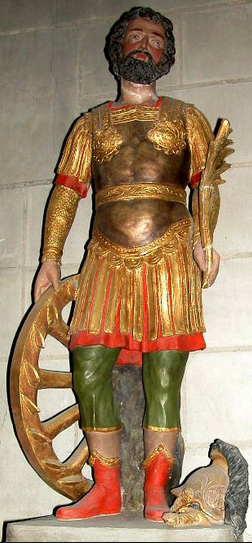THE COPTIC EGYPTIAN ORIGIN OF THE NAME ‘NAPOLEON’
Who could have thought that the name Napoleon, which has been made famous by the French Napoleon Bonaparte (1769 – 1821), is Coptic Egyptian in origin? I have certainly come across one Copt who was called Nabillione (Napoleon), and his name had always intrigued me. I have no doubt that he was named after Bonaparte; as Copts sometimes gave their children French or British names, such as Kitchener and Victoria .
But recently, as I was reading Napoleon by Vincent Cronin, an excellent biography of the French Emperor Napoleon Bonaparte, I learned that he was called Napoleone after one of his mother’s Corsican uncles who had fought the French and just recently died. Apparently, the name Napoleone was common in Corsica, where Bonaparte was born. The French form of the name is Napoléon ; however, in Corsican lips the name sounds as Nabllione. But what’s really interesting is that « Originally, Napoleone was the name of an Egyptian martyr who suffered in Alexandria under Diocletian. »
Now, I have to say that I never thought that. Certainly I had never come across an Egyptian martyr during the Great Persecution in early fourth century who carried the name Napoleon or something close to the name. I have checked the Coptic Synaxarium and could not find any record of a saint or martyr Napoleon. The Ethiopian Synaxarium which was taken from the Coptic Synaxarium does not mention the name too.
However,it does appear that Napolion was actually a saint and a martyr, and he did die at Alexandria in the times of the Roman Emperor Diocletian! A book which was published in 1846 in Paris under the title «Légende céleste, Vie des Saints” does confirm that there was a saint and martyr by that name. The original name seems to be Neopulus or Neopolus or Neopolis; and the Catholic Church celebrates his feast on 15 August, which is corresponding to 9 Mesori. Several churches in France have icons and statues of St. Napoleon; such as the one (below) at L’église Saint-André (Church of Saint Andrew) located in Argent-sur-Sauldre.
 Statue of St. Napoleon at L’église Saint-André (Church of Saint Andrew), Argent-sur-Sauldre, France
Statue of St. Napoleon at L’église Saint-André (Church of Saint Andrew), Argent-sur-Sauldre, France
What explains the absence of any mentioning of the martyr in the Coptic Synaxarium? The Coptic Synaxarium was compiled in Arabic in the twelfth century in Egypt from earlier sources written in Coptic and Greek. There is evidence that many martyrs and saints were not included in the Synaxarium most probably because the authors did not find the original sources for them in Coptic or Greek since many Coptic manuscripts were either destroyed or lost in consequence of the Muslim persecution of the Copts since the 7th century. Many of these documents were found in modern age in hidden caches. It appears that the story of St. Napoleon (Neopolus/Neopulus/Neopolis) was not available to the authors of the Coptic Synaxarium in the 13th century and the manuscript that recorded his martyrdom is still missing. Hope one day it will be found. Hope, too, that the Copts will start naming their children after this martyr !

Napoleons’ birthday – 15th Aug, is also the feast day of St. Neopulus
LikeLike